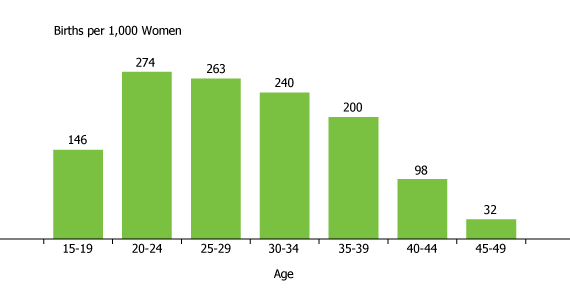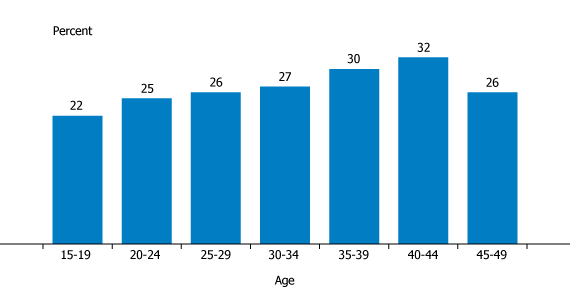
Older Zambian Women's Reproductive Health Often Overlooked
Brian Munkombwe is a Ph.D. candidate in Applied Demography at the University of Texas at San Antonio. He was a participant in PRB’s 2012-2013 Policy Communication Fellows Program, funded by USAID through the IDEA project. This article was written as part of the Fellows Program.
(May 2013) In Zambia, girls often start childbearing before they are 18 years old, and many women end childbearing after the age of 35 (see Figure 1).1 This long period of childbearing contributes to Zambia’s high total fertility rate, or average number of children per woman, which at 6.2 is one of the highest in sub-Saharan Africa.
Figure 1
Number of Births to Women in Zambia, by Age Group

Source: Central Statistical Office, Ministry of Health, Tropical Diseases Research Center, University of Zambia, and Macro International Inc., Zambia Demographic and Health Survey 2007 (Calverton, MD: Macro International, 2009).
While mothers who give birth at a young age have received much attention due to their greater risks of complications at birth, women who give birth at a later age (35 or older) have not yet received adequate attention from programs seeking to improve maternal health in Zambia.
The risks to maternal and newborn health for older mothers are high. For example, maternal mortality rates for older mothers are 120 deaths per 100,000 live births, compared with 73 deaths per 100,000 live births for mothers ages 20 to 24. And infant mortality rates for children born to older mothers are higher, 91 deaths per 1,000 live births, compared with 78 for children whose mothers were ages 20 to 29.2
Consequences of Pregnancies for Older Women
The consequences of late pregnancies are increased risks for complications, including a greater risk of miscarriage, newborn deaths, or even death of the mother. A number of studies have shown that the chances of dying during childbirth, for either the mother or the newborn, are high for both mothers under age 18 and women over age 35.3 Women over 35 may also be at greater risks of miscarriage, infant death, and maternal death if they have poor reproductive health behaviors, such as low use of family planning services, antenatal care, and deliveries outside a health facility.
Older Women’s Reproductive and Maternal Health in Zambia
According to the 2007 Zambia Demographic and Health Survey, one in three women ages 35 to 44 do not use any form of contraception, increasing the odds of a high-risk pregnancy. In addition, many women over age 35 do not want to have more children, and as a result, older women have the highest levels of unmet need for family planning, meaning they do not want to become pregnant but are not using a modern method of family planning (see Figure 2). Unintended pregnancies and inadequate birth spacing can also increase risk for complications.
Figure 2
Percentage of Women in Zambia Ages 15-49 With Unmet Need for Family Planning

Source: Central Statistical Office, Ministry of Health, Tropical Diseases Research Center, University of Zambia, and Macro International Inc., Zambia Demographic and Health Survey 2007 (Calverton, MD: Macro International, 2009).
The 2007 Zambia DHS also revealed that older women are less likely to seek antenatal care or deliver with a skilled attendant. One in five women ages 35 to 49 had no antenatal visits during her last pregnancy. The lack of antenatal care among older women leads to late identification and intervention of pregnancy-related complications. Older women in Zambia are also more likely to give birth at home without the help of a skilled birth attendant. Only 42 percent of women ages 34 to 49 deliver in a health facility, compared with 62 percent of women under age 20, and 52 percent of women ages 20 to 33.
Recommendations
Most donor and government programs in Zambia that address childbirth complications and outcomes as a result of maternal age are mainly focused on girls ages 15 to 19, but older women have a similar risk. Increased attention on older women to improve their reproductive health and decrease their risk of newborn and maternal health complications will help Zambia advance toward meeting Millennium Development Goals 4 and 5: to reduce child mortality and improve maternal health.
References
- Central Statistical Office, Ministry of Health, Tropical Diseases Research Center, University of Zambia, and Macro International Inc., Zambia Demographic and Health Survey 2007 (Calverton, MD: Macro International, 2009).
- Central Statistical Office, Ministry of Health, Tropical Diseases Research Center, University of Zambia, and Macro International Inc., Zambia Demographic and Health Survey 2007.
- Joy E. Lawn et al., “4 Million Neonatal Deaths: When? Where? Why?” The Lancet 365, no. 9462 (2005): 891-900.
